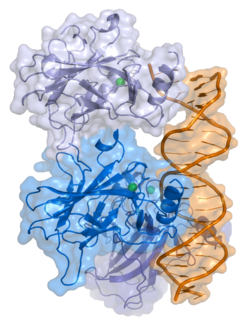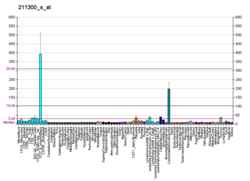
Back P53 Afrikaans بي53 Arabic P53 Catalan P53 Czech TP53 Welsh P53 Danish P53 German P53 English P53 Spanish P53 Estonian
Tumorski protein P53, znan i kao p53, ćelijski tumorski-antigen p53 (UniProt ime), domaćinski gen,[5] fosfoprotein p53, tumorski supresor p53, antigen NY-CO-13 ili transformacijski vezani protein 53 (TRP53), je bilo koja proteinska izoforma proteina kodiranog homolognim genom u različitim organizmima, kao što su TP53 (ljudi) i Trp53 (miševi). Ovaj homolog (za koji se prvobitno mislilo da je, i o njemu se često govori, kao jedan protein) presudan je u višim kičmenjacima, gdje sprečava stvaranje karcinoma, te stoga funkcionira kao supresor tumora.[6] Kao takav, p53 je opisan kao "čuvar genoma" zbog svoje uloge u očuvanju stabilnosti, sprečavanjem mutacije genoma.[7] Stoga se TP53 koriste za označavanje imena gena TP53 i razlikovanje od proteina koje kodiraju (klasificiran je kao gen za supresiju tumora).[8][9][10][11][12]
Naziv 'p53' dobio je 1979. godine opisujući prividnu molekulskuu masu. Analiza SDS-PAGE pokazuje da je riječ o proteinu od 53-kilodaltona (kDa). Međutim, stvarna masa proteina p53 pune dužine (p53α) na osnovu zbroja mase aminokiselinskih ostataka iznosi samo 43,7 kDa. Ova razlika je zbog velikog broja prolinskih ostataka u proteinu, koji usporavaju njegovu migraciju na SDS-PAGE, čineći ga tako težim nego što zapravo jeste.[13] Pored proteina pune dužine, ljudski gen TP53 kodira najmanje 15 izoformnih proteina, veličine od 3,5 do 43,7 kDa. Svi ovi proteini p53 nazivaju se izoformama p53.[6] Gen TP53 je najčešće mutirani gen (> 50%) u karcinomu čovjeka, što ukazuje da TP53 ima presudnu ulogu u sprečavanju stvaranja karcinoma. Gen TP53 kodira proteine koji se vežu za DNK i regulišu ekspresiju, kako bi se spriječile mutacije genoma.[14]
- ^ a b c GRCh38: Ensembl release 89: ENSG00000141510 - Ensembl, maj 2017
- ^ a b c GRCm38: Ensembl release 89: ENSMUSG00000059552 - Ensembl, maj 2017
- ^ "Human PubMed Reference:". National Center for Biotechnology Information, U.S. National Library of Medicine.
- ^ "Mouse PubMed Reference:". National Center for Biotechnology Information, U.S. National Library of Medicine.
- ^ Toufektchan, E.; Toledo, F. (2018). "The Guardian of the Genome Revisited: P53 Downregulates Genes Required for Telomere Maintenance, DNA Repair, and Centromere Structure". Cancers. 10 (5): 135. doi:10.3390/cancers10050135. PMC 5977108. PMID 29734785.
- ^ a b Surget S, Khoury MP, Bourdon JC (decembar 2013). "Uncovering the role of p53 splice variants in human malignancy: a clinical perspective". OncoTargets and Therapy. 7: 57–68. doi:10.2147/OTT.S53876. PMC 3872270. PMID 24379683.
- ^ Read AP, Strachan T (1999). "Chapter 18: Cancer Genetics". Human molecular genetics 2. New York: Wiley. ISBN 978-0-471-33061-5.
- ^ Matlashewski G, Lamb P, Pim D, Peacock J, Crawford L, Benchimol S (decembar 1984). "Isolation and characterization of a human p53 cDNA clone: expression of the human p53 gene". The EMBO Journal. 3 (13): 3257–62. doi:10.1002/j.1460-2075.1984.tb02287.x. PMC 557846. PMID 6396087.
- ^ Isobe M, Emanuel BS, Givol D, Oren M, Croce CM (1986). "Localization of gene for human p53 tumour antigen to band 17p13". Nature. 320 (6057): 84–5. Bibcode:1986Natur.320...84I. doi:10.1038/320084a0. PMID 3456488. S2CID 4310476.
- ^ Kern SE, Kinzler KW, Bruskin A, Jarosz D, Friedman P, Prives C, Vogelstein B (juni 1991). "Identification of p53 as a sequence-specific DNA-binding protein". Science. 252 (5013): 1708–11. Bibcode:1991Sci...252.1708K. doi:10.1126/science.2047879. PMID 2047879. S2CID 19647885.
- ^ McBride OW, Merry D, Givol D (januar 1986). "The gene for human p53 cellular tumor antigen is located on chromosome 17 short arm (17p13)". Proceedings of the National Academy of Sciences of the United States of America. 83 (1): 130–4. Bibcode:1986PNAS...83..130M. doi:10.1073/pnas.83.1.130. PMC 322805. PMID 3001719.
- ^ Greška kod citiranja: Nevaljana oznaka
<ref>; nije naveden tekst za reference s imenomBourdon - ^ Ziemer MA, Mason A, Carlson DM (septembar 1982). "Cell-free translations of proline-rich protein mRNAs". The Journal of Biological Chemistry. 257 (18): 11176–80. doi:10.1016/S0021-9258(18)33948-6. PMID 7107651.
- ^ Levine AJ, Lane DP, ured. (2010). The p53 family. Cold Spring Harbor Perspectives in Biology. Cold Spring Harbor, N.Y.: Cold Spring Harbor Laboratory Press. ISBN 978-0-87969-830-0.






